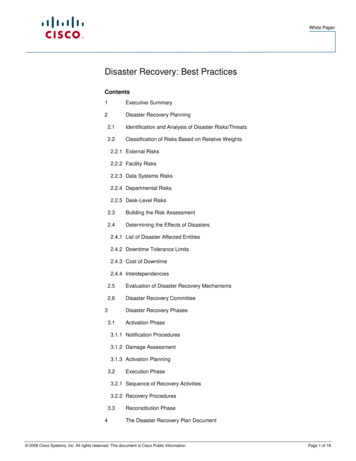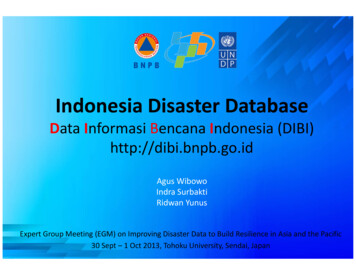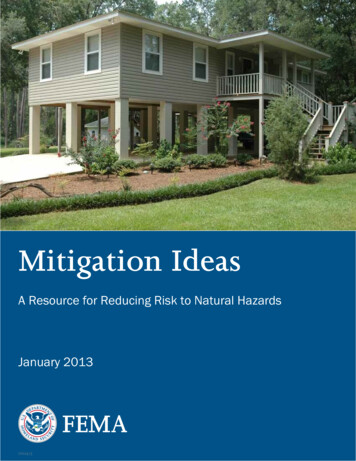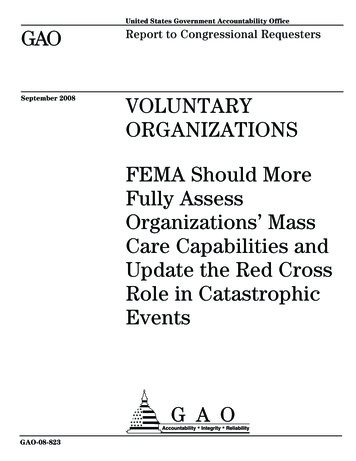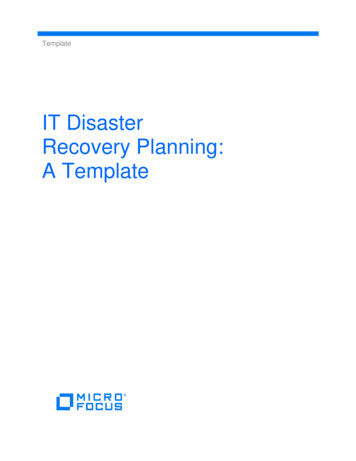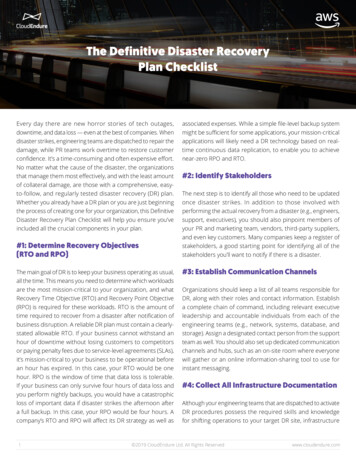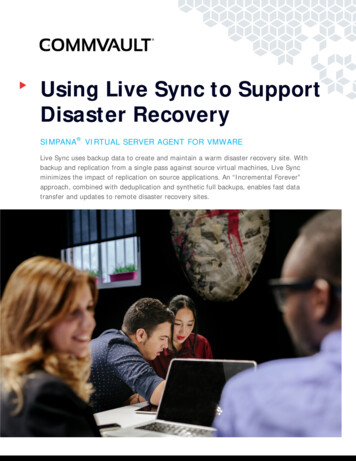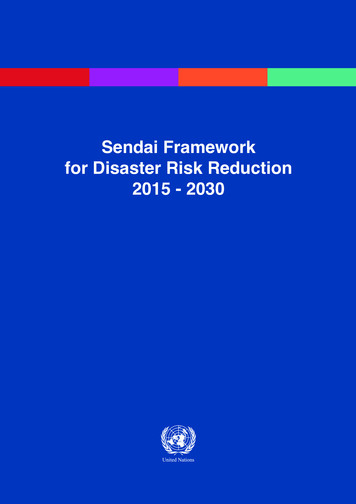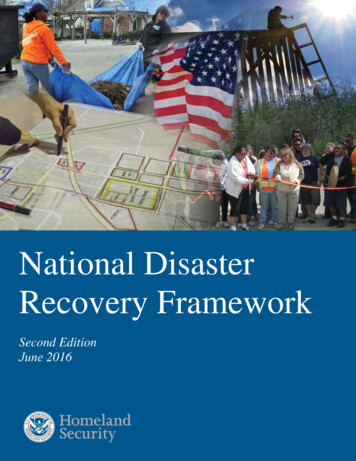
Transcription
National DisasterRecovery FrameworkSecond EditionJune 2016
National Disaster Recovery FrameworkExecutive Summar yThe National Disaster Recovery Framework (NDRF) establishes a common platform and forum forhow the whole community builds, sustains, and coordinates delivery of recovery capabilities.Resilient and sustainable recovery encompasses more than the restoration of a community’s physicalstructures to pre-disaster conditions. Through effective coordination of partners and resources, wecan ensure the continuity of services and support to meet the needs of affected community memberswho have experienced the hardships of financial, emotional, and/or physical impacts of devastatingdisasters.The primary value of the NDRF is its emphasis on preparing for recovery in advance of disaster. Theability of a community to accelerate the recovery process begins with its efforts in pre-disasterpreparedness, including coordinating with whole community partners, mitigating risks, incorporatingcontinuity planning, identifying resources, and developing capacity to effectively manage therecovery process, and through collaborative and inclusive planning processes. Collaboration acrossthe whole community provides an opportunity to integrate mitigation, resilience, and sustainabilityinto the community’s short- and long-term recovery goals.This Framework is always in effect, and elements can be implemented at any time. Thestructures, roles, and responsibilities described in this Framework can be partially or fullyimplemented in the context of a threat or hazard, in anticipation of a significant event, or followingan incident. Selective implementation of the NDRF allows for a scalable and deliberate delivery ofspecific resources and capabilities and a level of coordination appropriate for each incident. Buildingon a wealth of objective and evidence-based knowledge and community experience, this Frameworkseeks to increase awareness of recovery capabilities across the whole community.Key elements of the NDRF since it was first published in 2011 that are significant for all readers arethe guiding principles and the Recovery core capabilities. The NDRF is guided by eight principlesthat when put into practice, maximize the opportunity for achieving recovery success. The guidingprinciples remind us of the importance of how we work together to support survivor needs and buildresilience: Individual and Family Empowerment; Leadership and Local Primacy; Pre-Disaster Recovery Planning; Engaged Partnerships and Inclusiveness; Unity of Effort; Timeliness and Flexibility; Resilience and Sustainability; and Psychological and Emotional Recovery.This edition of the NDRF highlights and further defines the eight Recovery core capabilities—criticalfunctions to enable preparedness and recovery—as identified in the National Preparedness Goal.Three core capabilities are common to all five mission areas: Planning; Public Information andWarning; and Operational Coordination. The remaining five are specific to recovery: Economic Recovery;i
National Disaster Recovery Framework Health and Social Services; Housing; Infrastructure Systems; and Natural and Cultural Resources.The NDRF focuses on ensuring that the Nation will be able to achieve recovery following anyincident regardless of size or scale, and considers the full spectrum of threats and hazards, includingnatural, technological/accidental, and adversarial/human-caused. The NDRF helps ensure that allcommunities can coordinate recovery efforts to address their unique needs, capabilities,demographics, and governing structures. It encourages an inclusive recovery process, engagingtraditional and nontraditional whole community partners, and provides a strategic and nationalapproach to lead, manage, and coordinate recovery efforts while increasing the resilience of ourcommunities.ii
National Disaster Recovery FrameworkTable of ContentsExecutive Summary . iIntroduction . 1Framework Purpose and Organization .1Evolution of the National Disaster Recovery Framework .3Intended Audience .3Scope . 4Recovery Continuum .4Guiding Principles .5Risk-Basis.8Roles and Responsibilities. 9Ensuring Inclusion of Whole Community .10Individuals, Families, and Households .11Nongovernmental Organizations.11Private Sector Entities .13Local Governments .14State, Tribal, Territorial and Insular Area Governments .17Federal Government .21Core Capabilities . 24Planning .25Public Information and Warning .27Operational Coordination .28Economic Recovery .29Health and Social Services .30Housing .30Infrastructure Systems .31Natural and Cultural Resources .32iii
National Disaster Recovery FrameworkCoordinating Structures and Integration . 33Nongovernmental Organizations Coordinating Structures .34Local Coordinating Structures .35State/Territorial Coordinating Structures .35Tribal Coordinating Structures .36Federal Coordinating Structures.36Integration .42Relationship to Other Mission Areas. 43Prevention .43Protection .44Mitigation.44Response.44Operational Planning . 44Planning Assumptions .45Planning Activities .45Framework Application. 48Achieving Successful Recovery .49Measuring Recovery Progress .50Supporting Resources . 51Conclusion. 52iv
National Disaster Recovery FrameworkIntroductionThe National Preparedness System outlines an organized process for the whole community to moveforward with their preparedness activities and achieve the National Preparedness Goal. The NationalPreparedness System integrates efforts across five preparedness mission areas—Prevention,Protection, Mitigation, Response, and Recovery—in order to achieve the goal of a secure andresilient Nation. The National Disaster Recovery Framework (NDRF), part of the NationalPreparedness System, outlines the strategy and doctrine for how the whole community 1 builds,sustains, and coordinates delivery of Recovery core capabilities identified in the NationalPreparedness Goal in an integrated manner with the other mission areas. This second edition of theNDRF reflects the insights and lessons learned from real-world incidents and the implementation ofthe National Preparedness System.Prevention: The capabilities necessary to avoid, prevent, or stop a threatened or actualact of terrorism. Within national preparedness, the term “prevention” refers to preventingimminent threats.Protection: The capabilities necessary to secure the homeland against acts of terrorismand man-made or natural disasters.Mitigation: The capabilities necessary to reduce loss of life and property by lesseningthe impact of disasters.Response: The capabilities necessary to save lives, protect property and theenvironment, and meet basic human needs after an incident has occurred.Recovery: The capabilities necessary to assist communities affected by an incident torecover effectively.F r a m ew o r k P u rp o s e an d O rg an i z at i o nAs a component of national doctrine, the NDRF describes principles, processes, and capabilitiesessential for all communities to more effectively manage and enable recovery following an incidentof any size or scale. This Framework defines how the whole community, including emergencymanagers, community development professionals, recovery practitioners, government agencies,private sector, nongovernmental organization (NGO) leaders, and the public, will collaborate andcoordinate to more effectively utilize existing resources to promote resilience and support therecovery of those affected by an incident. The National Preparedness Goal defines resilience as “theability to adapt to changing conditions and withstand and rapidly recover from disruption due toemergencies.”The NDRF advances the concept that recovery extends beyond simply repairing damaged structures.It also includes the continuation or restoration of services critical to supporting the physical,emotional, and financial well-being of impacted community members. Recovery includes therestoration and strengthening of key systems and resource assets that are critical to the economicstability, vitality, and long-term sustainability of the communities themselves. These include health1The whole community includes individuals and communities, the private and nonprofit sectors, faith-basedorganizations, and all levels of government (local, regional/metropolitan, state, tribal, territorial, insular area, andFederal). Whole community is defined in the National Preparedness Goal as “a focus on enabling the participation innational preparedness activities of a wider range of players from the private and nonprofit sectors, includingnongovernmental organizations and the general public, in conjunction with the participation of all levels ofgovernment in order to foster better coordination and working relationships.”1
National Disaster Recovery Framework(including behavioral health) and human services capabilities and networks, public and privatedisability support and service systems, educational systems, community social networks, natural andcultural resources, affordable and accessible housing, infrastructure systems, and local and regionaleconomic drivers. Together, these elements of recovery contribute to rebuilding resilientcommunities equipped with the physical, social, cultural, economic, and natural infrastructurerequired to meet future needs.This Framework establishes scalable, flexible, and adaptable coordinating platforms that align keyroles and responsibilities across the whole community and depicts a process in which a communityfully engages and considers the needs of all its members. A key element of the process is that thecommunity assumes leadership in developing recovery priorities and activities that are realistic, wellplanned, and clearly communicated. The ability of a community to accelerate the recovery processbegins with its efforts in preparedness, to include coordinating whole community partners, mitigatingrisks, incorporating continuity planning, identifying resources, and developing capacity to effectivelymanage recovery, and through collaborative and inclusive planning processes. These efforts result ina more resilient community with an improved ability to withstand, respond to, and recover fromdisasters.This Framework provides guidance to recovery leaders and stakeholders by: Identifying guiding principles for achieving successful recovery; Outlining pre- and post-disaster roles and responsibilities for recovery stakeholders andrecommending leadership roles across all levels of government; Describing how the whole community will build, sustain, and coordinate the delivery of theRecovery core capabilities; Explaining the relationship between Recovery and the other mission areas (Prevention,Protection, Mitigation, and Response); Promoting inclusive and equitable coordination, planning, and information sharing processes; Encouraging the whole community to leverage opportunities to increase resilience andincorporate climate adaptation and mitigation measures pre- and post-disaster, such as continuityplanning and land use and environmental regulations; Identifying scalable and adaptable organizations for coordinating recovery; Describing key factors, activities, and considerations for pre- and post-disaster recoveryplanning; and Ensuring recovery resources are sourced from a wide range of whole community partners,including individuals and voluntary, nonprofit, philanthropic, and private sector andgovernmental agencies and organizations.Following any incident, regardless of size or scale, affected communities will have recovery needsand require access to resources that necessitate an effective management and coordination process.As national doctrine, the NDRF is always in effect and principles should be implemented pre- andpost-disaster. The majority of incidents are managed by local, regional/metropolitan, state, tribal,territorial, and insular area governments without assistance from the Federal Government. Theguiding principles and whole community roles, responsibilities, resources, and coordinationmechanisms outlined in this Framework are equally valid for incidents that do not receive additionalassistance. This Framework highlights types of recovery resources such as information for decision-2
National Disaster Recovery Frameworkmaking, technical assistance, subject matter expertise, labor, and equipment, as well as coordinationand funding mechanisms; and the whole community partners from which they are sourced, to includeinsurance companies, NGOs such as voluntary, faith-based, nonprofit, and philanthropicorganizations, and government departments and agencies.This Framework is not intended to alter or impede the ability of any local, regional/metropolitan,state, tribal, territorial, insular area, or Federal government department or agency to carry out itsauthorities or to comply with applicable laws, executive orders, and directives. Instead, it requires thewhole community to coordinate or integrate individual authorities and missions. As the NDRFapplies to all incidents, its structures and procedures apply equally to incidents where Federal supportto local, regional/metropolitan, state, tribal, territorial, and insular area governments is coordinatedunder the Robert T. Stafford Disaster Relief and Emergency Assistance Act (Stafford Act) and toincidents where Federal departments and agencies exercise other authorities and responsibilitiesoutside the Stafford Act. After the 2010 Deepwater Horizon oil spill, for example, Federal responseand support was managed pursuant to the Oil Pollution Act. Other statutes such as the HomelandSecurity Act, Small Business Act, the Farm Bill, and the Public Health Service Act authorizesubstantive Federal assistance in response to certain types of incidents. The costs of direct Federalrecovery support will continue to be borne by agencies using appropriations made for such purposes,except for those expenses authorized for reimbursement under the Stafford Act or as otherwiseprovided by law. When recovery requirements extend over long periods of time, steady stateprograms may be leveraged to support recovery efforts.E vo l u t i o n o f t h e N D R FIn 2009, more than 600 recovery stakeholders representing local, regional/metropolitan, state, tribal,territorial, insular area and Federal governments, as well as public and private sector organizationsfrom across the Nation, were brought together to help inform the development of a recoveryframework. The guiding principles and key elements of leadership, coordination, and pre-disasterplanning identified through the national stakeholder process formed the foundation of the first editionof the NDRF published in 2011. The core principles and key concepts remain relevant and continueto guide pre- and post-disaster recovery at all levels of government. Many local,regional/metropolitan, state, tribal, territorial, insular area, and Federal governments haveimplemented these principles in developing pre-disaster recovery plans and incorporated exemplarycoordination mechanisms following a wide range of incidents. 2In conjunction with the National Planning Frameworks for other mission areas, this documentexpands on the integration and interrelationships among the other mission areas of Prevention,Protection, Mitigation, and Response. It incorporates lessons learned and best practices from realworld incidents and national level exercises. 3 This Framework provides a strategic nationalperspective to enable coordination, information sharing, and increased resilience across the wholecommunity regardless of the threat or hazard.I n t en d ed Au d i en ceAlthough the NDRF is intended to provide guidance for the whole community, if focuses especiallyon the needs of those who are involved in delivering and applying the Recovery core capabilities2Case studies can be found in the guidance document Effective Coordination of Recovery Resources for State,Tribal, Territorial and Local Incidents at s/101940.3Lessons learned, innovative practices, after-action reports, plans, templates, guides, and other materials can befound on Naval Postgraduate School’s Homeland Security Digital Library at HSDL.org and on FEMA.gov.3
National Disaster Recovery Frameworkdefined in the National Preparedness Goal. Recovery practitioners will find guidance on Recoverycore capabilities and critical recovery functions such as leadership, organizational and coordinationstructures, key recovery partners, applicable resources, and inclusive public engagement andcommunication strategies. For stakeholders involved in Prevention, Protection, Mitigation, andResponse mission areas, the NDRF identifies the objectives, principles, practices, and stakeholdersthat lead, manage, and guide disaster recovery. Educating a broad audience on pre- and post-disasterrecovery principles, processes, and capabilities will increase resilience and further enhanceintegration and coordination across mission areas and the whole community.Engaging the whole community is critical to success, and individual and community preparedness isa key component. By providing equal access to acquire and use the necessary knowledge and skills,this Framework seeks to enable the whole community to contribute to and benefit from nationalpreparedness. This includes children 4; older adults; individuals with disabilities and others withaccess and functional needs 5; those from religious, racial, and ethnically diverse backgrounds; peoplewith limited English proficiency; and owners of animals including household pets and serviceanimals. Directly engaging people with different kinds of needs or disabilities in the planning processenhances national preparedness efforts. The NDRF provides a framework under which these variousindividuals and groups can work together and coordinate resources to support those affected by anincident, because a successful recovery requires the active commitment of the whole community.ScopeThe Recovery mission area defines capabilities necessary for communities affected or threatened byany incident to rebuild infrastructure systems, provide adequate, accessible interim and long-termhousing that meets the needs of all survivors, revitalize health systems (including behavioral health)and social and community services, promote economic development, and restore natural and culturalresources. The ability to manage recovery effectively begins with pre-disaster preparedness andrequires support and resources focused on recovery at the immediate onset of an incident.R e co ve r y Co n t i n u u mThe recovery process is best described as a sequence of interdependent and often concurrentactivities that progressively advance a community toward its planned recovery outcomes. Decisionsmade and priorities set by a community pre-disaster and early in the recovery process have acascading effect on the nature, speed, and inclusiveness of recovery. Figure 1 depicts theinterconnectedness of recovery activities from pre-incident through the long term.4Children require a unique set of considerations across the core capabilities contained within this document. Theirneeds must be taken into consideration as part of any integrated planning effort.5Individuals having access and functional needs refers to persons who may have additional needs before, during andafter an incident in functional areas, including but not limited to: maintaining health, independence, communication,transportation, support, services, self-determination, and medical care. Individuals in need of additional responseassistance may include those who have disabilities; live in institutionalized settings; are older adults; are children;are from diverse cultures; have limited English proficiency or are non-English speaking; or are transportationdisadvantaged.4
National Disaster Recovery FrameworkFigure 1: Recovery ContinuumThe Recovery Continuum highlights the reality that, for a community faced with significant andwidespread disaster impacts, preparedness, response, and recovery are not and cannot be separate andsequential efforts. Laying an effective foundation for recovery outcomes is a key requirement ofresponse activities, but planning for recovery begins before response. Community-level planning forrecovery is a preparedness-phase activity that strengthenscontinuity and response and hastens recovery. Thechallenge is to ensure adequate and effective coordinationGuiding Principlesbetween different efforts and players, as the decisions andoutcomes for all phases are interconnected.1. Individual and FamilyAn example is a major employer deciding to relocaterather than rebuild because it perceives that destroyedhousing, roads, retail, and basic government services arenot being restored and rebuilt timely and adequately. Thisoutcome may have been avoided by including theemployer in pre- and post-disaster recovery planningefforts and maintaining close coordination after theincident.G u i d i n g P ri n ci p l esThe following subsections detail eight principles thatguide Recovery core capability development andrecovery support activities under the NDRF. When putinto practice, these principles maximize the opportunityfor achieving recovery success.Empowerment2. Leadership and Local Primacy3. Pre-Disaster Recovery Planning4. Engaged Partnerships andInclusiveness5. Unity of Effort6. Timeliness and Flexibility7. Resilience and Sustainability8. Psychological and EmotionalRecoveryIndividual and Family EmpowermentSuccessful recovery includes the ability of individuals and families to rebound from their losses in amanner that sustains their physical, emotional, social, and economic well-being, and all community5
National Disaster Recovery Frameworkmembers must have equal opportunity to participate in community recovery efforts in a meaningfulway. Care must be taken to assure that actions, both intentional and unintentional, do not excludegroups of people based on race, color, ethnicity, national origin (including limited Englishproficiency), religion, sex, sexual orientation, gender identity, age, or disability. Care must also betaken to identify and remove social and institutional barriers that hinder or preclude individuals withdisabilities, and others in the community historically subjected to unequal treatment, from full andequal enjoyment of the programs, goods, services, activities, facilities, privileges, advantages, andaccommodations provided. It is vital that all individuals, including owners and their animals(including household pets and service and assistance animals) are provided with the tools to accessand use a continuum of community support and resources that addresses both the physical lossessustained and the psychological and emotional trauma experienced.Leadership and Local PrimacySuccessful recovery requires informed and coordinated leadership throughout all levels ofgovernment, sectors of society, and phases of the recovery process. It recognizes that local,regional/metropolitan, state, tribal, territorial, insular area, and Federal governments have primaryresponsibility for the recovery of their communities and play the lead role in planning for andmanaging all aspects of community recovery. This is a basic, underlying principle that should not beoverlooked by local, regional/metropolitan, state, tribal, territorial, insular area, and Federal, andother recovery and emergency managers. Local, regional/metropolitan, state, tribal, territorial, andinsular areas act in support of their communities, evaluate their capabilities, and provide a means ofsupport for overwhelmed local governments. The Federal Government is a partner and facilitator inrecovery, prepared to quickly enhance its role when the incident impacts relate to areas whereFederal jurisdiction is primary or affects national security. While acknowledging the primary role oflocal, regional/metropolitan, state, tribal, territorial, insular area governments, the FederalGovernment is prepared to provide support following a major disaster or catastrophic incident.Pre-Disaster Recovery PlanningThe speed and effectiveness of recovery operations, and the resilience of outcomes associated withthem, can be greatly improved through pre-disaster recovery planning. The scale and magnitude ofrecovery needs can also be reduced through pre-disaster actions. All stakeholders, including othermission area partners such as Response and Mitigation, need to be involved to ensure a coordinatedand comprehensive planning process 6, and to develop relationships that increase post-disastercollaboration and unified decision-making. Discussion and collaboration will also facilitate thedevelopment of a common definition of success. Pre-disaster recovery planning will helpcommunities take pre- and post-disaster actions that significantly reduce future disaster impacts. Byfocusing on likely impacts, pre-disaster planning identifies avenues for near-term mitigation throughmeans such as building codes that encourage disaster resilient building practices, and for long-termmitigation through reconstruction land use plans that avoid risk areas. In addition, all partnersinvolved will work together to build and develop their collective capacity and capability to lead, plan,and manage their recovery and increase their overall resilience. Encouraging innovative pre-disasterpla
that when put into practice, maximize the opportunity for achieving recovery success. The guiding principles remind us of the importance of how we work together to support survivor needs and build resilience: Individual and Family Empowerment; Leadership and Local Primacy; Pre-Disaster Recovery Planning;


